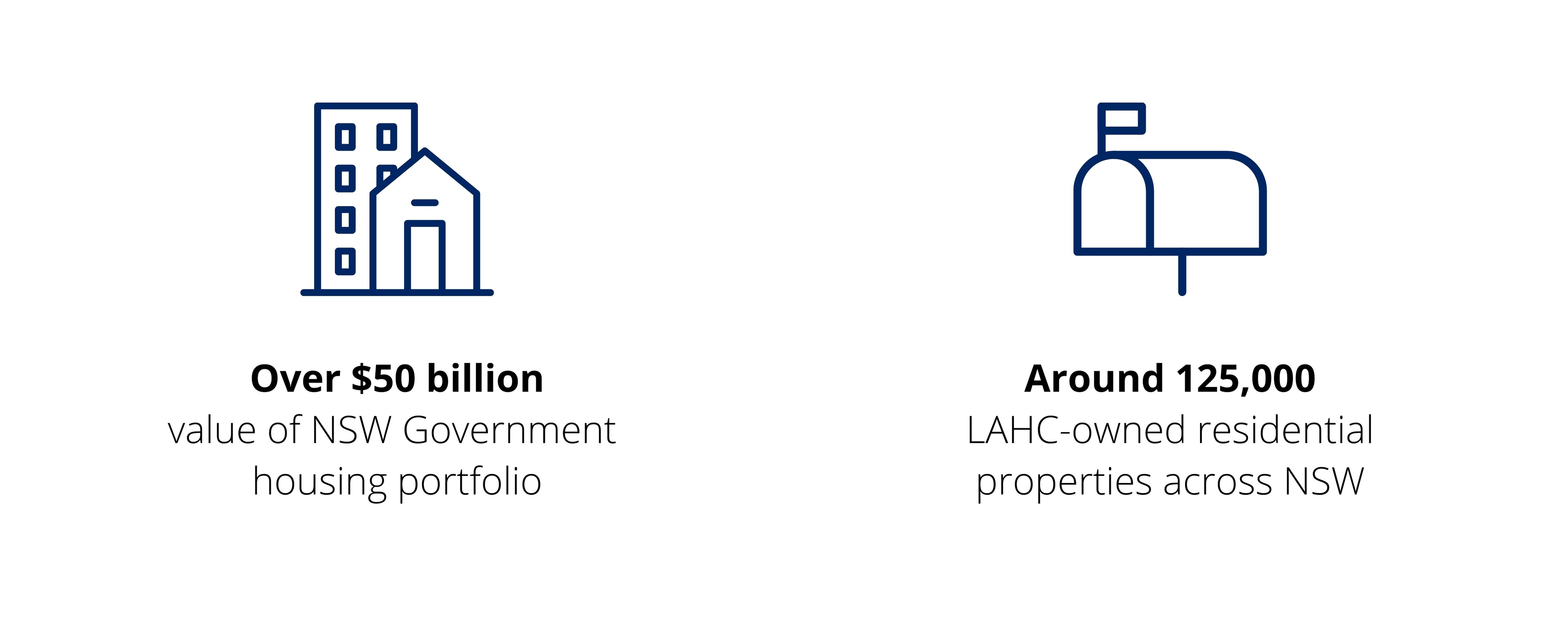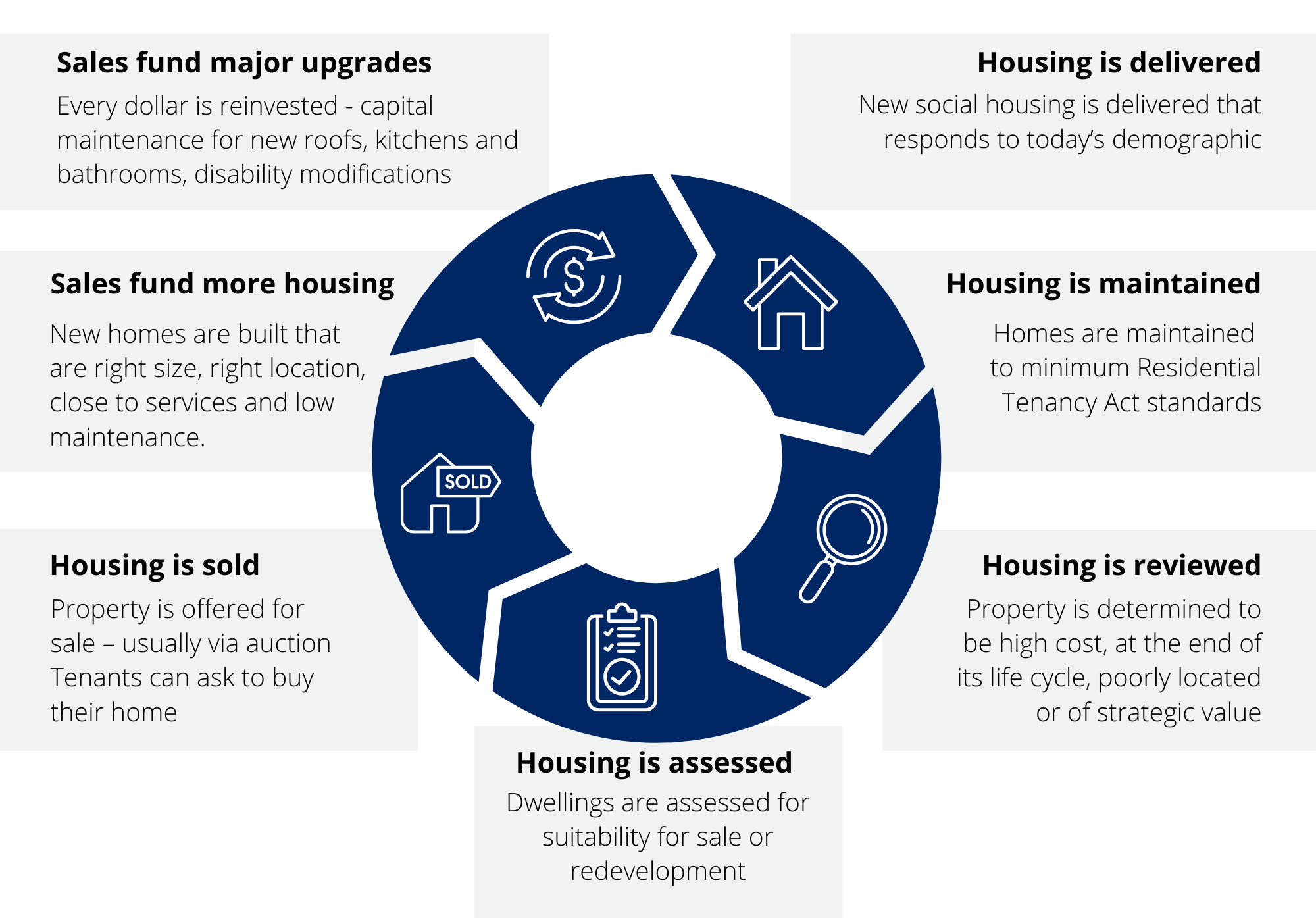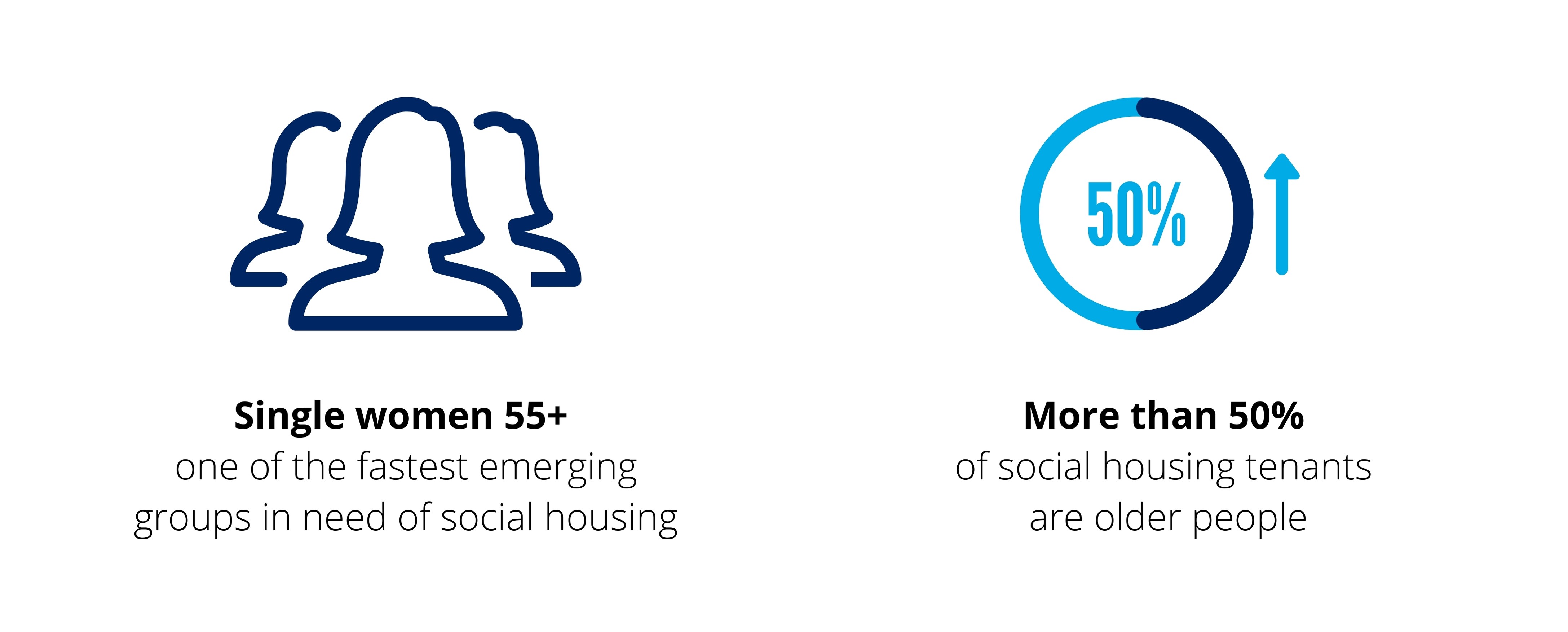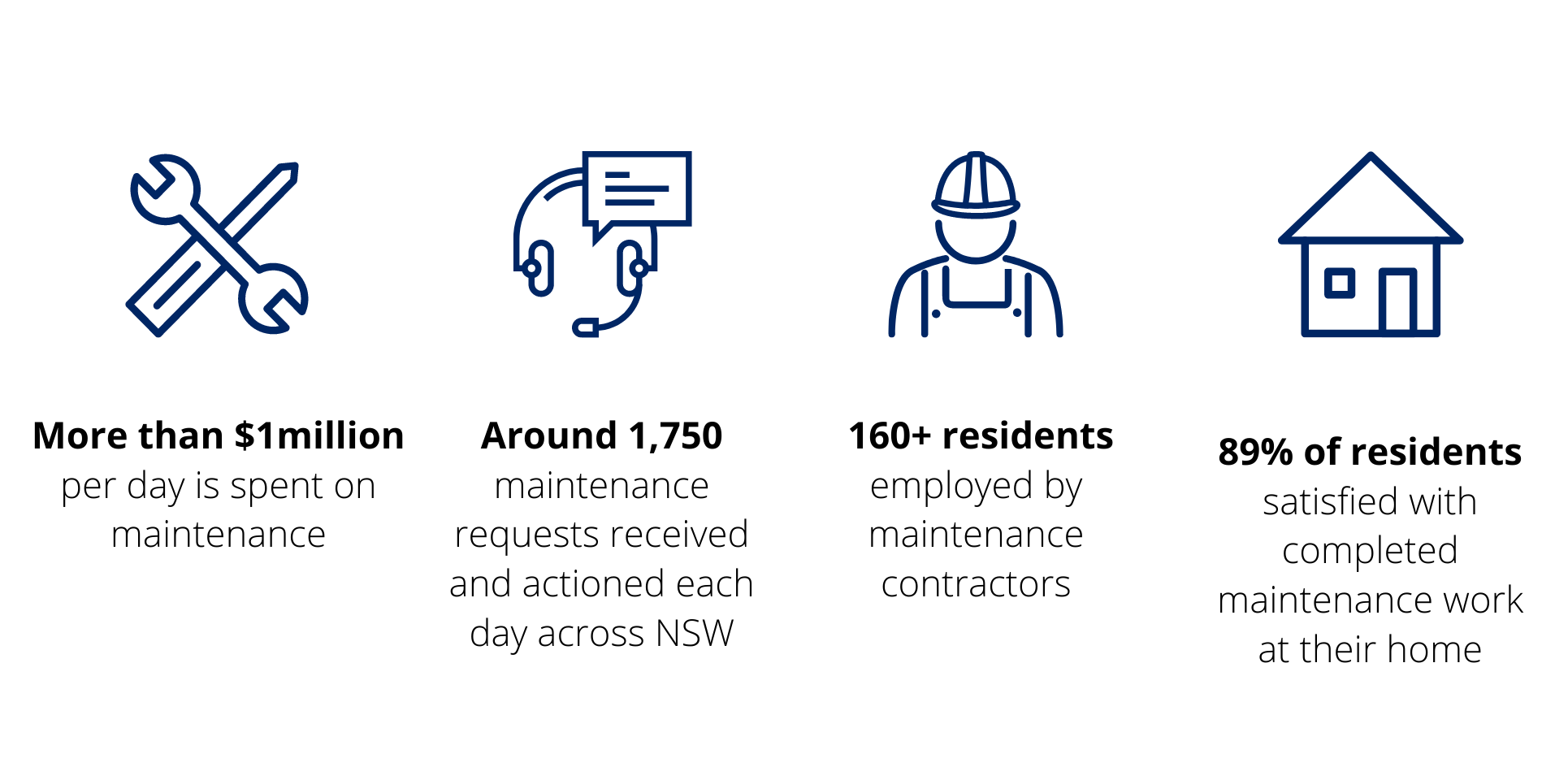The NSW Land and Housing Corporation (LAHC) is a self-funded Public Trading Enterprise (PTE), governed by the Housing Act 2001, and is part of the NSW Government’s Department of Planning and Environment (DPE).
We’re addressing an emerging need for social housing across NSW by building more and better social housing that responds to the needs of residents now and into the future.
Our new social housing is designed to be modern, fit-for-purpose and located close to vital community services like schools, shops, medical services, public spaces and transport links. Social housing that is integrated and well-designed strengthens communities, which provides better outcomes for residents and neighbours.
LAHC owns and manages the largest social housing portfolio in Australia and our work is guided by Future Directions for Social Housing in NSW, the NSW Government’s vision for a whole of government approach to deliver more and better social housing.
Our four strategic objectives, outlined in the Land and Housing Corporation Business Plan on a Page 2020-2024, are:
- More social housing
- Maintain asset standards
- Improve organisational sustainability and efficiency
- Effective stakeholder engagement.

Our business model
Building enough homes to address an ongoing need is the biggest challenge for LAHC and that’s why our business model is so important. LAHC is self-funded, and needs to generate its own income to build new social housing and maintain the properties we already have. We spend around $1 million every day just to maintain our homes so this requires close financial management.
We generate some income through rent, but this doesn’t cover the cost to manage, maintain and grow our portfolio. Therefore, to raise more revenue in a self-funded business model, we divest high-value properties or properties that are expensive to maintain, such as heritage buildings, so we can use that money to build more modern homes that are fit-for-purpose.
The properties we sell include older homes, and sometimes land lots and new private dwellings built by our delivery partners as part of mixed developments. This allows us to raise enough money to fund the construction of new fit-for-purpose homes.
Selling older homes to build new ones is also important to make sure our homes meet the needs of our residents. The residents of today don’t have the same needs as those from the 1950s or 60s when a lot of social housing was built. Today, almost 60% of our tenants are over 60 years old and there are fewer families and more single person households. That’s why we replace our older family homes with new homes built specifically for the people that will live in them.

Our business model creates a long-term cycle that takes income generated from selling high-cost and high-value properties and reinvests it into building more social housing that delivers better outcomes for tenants. This also raises our total number of homes to address the ongoing need for social housing.
One of our success stories is the Millers Point program where 419 older dwellings that were no longer fit-for-purpose were sold to fund the construction of around 1,900 new homes across NSW.
The majority of people across NSW support the need for more social housing. Currently, we have around a 99% occupancy rate, which means our homes are in very high demand. This is great because we have as many people in homes as possible, but it can be challenging when we plan to sell or redevelop our assets. That’s why we work closely with residents and the Department of Communities and Justice at each stage of the process. The ongoing safety and welfare of residents is our main priority.
Working with residents
We work closely with the Department of Communities and Justice who deliver high-quality tenancy services for residents. Responsibilities are shared across both organisations.
Land and Housing Corporation | Department of Communities and Justice |
|---|---|
Maintenance requests such as water leaks | Management of tenant complaints and anti-social behaviour |
Planned works such as the replacement of kitchens | Management of social housing waitlist and housing pathways |
Right to return for residents | Resident relocations |
Construction of new social housing | Administration of tenancy leasing and allocation of properties |
It’s important to make sure residents are in the right home at the right time of their life. This means residents may need to move to a home that’s better suited to their needs, or to help facilitate the delivery of more new social housing.
The majority of our residents and people on the waitlist are single, so, where possible, we try to build smaller homes that are easier to maintain, can respond to accessibility requirements, and offer lower bills by reducing the number of underused bedrooms.
When residents are required to relocate, suitable housing is sought within local or surrounding areas. At all stages of the relocation process, the ongoing safety and welfare of residents is always our main priority.
Building homes and careers for today and tomorrow
As well as delivering new social housing through our business model, we’re also helping build economies, jobs and communities around the state.
From inner-city Sydney to the country and the coast, the delivery of new homes is transforming local communities by creating jobs, encouraging new investment, and delivering housing for those who need it most.
Over the next five years, LAHC will deliver around 3,200 new homes across NSW. The construction of these homes will boost local economic activity with five jobs created for every $1 million the government invests – including one apprentice.
A key component of our work is building mixed communities that integrate private, affordable and social housing across NSW. This approach to social housing creates vibrant and successful communities connected to jobs, transport and essential services.
Initiatives to deliver mixed communities containing thousands of new homes for rent or purchase have already been launched at Midtown at Macquarie Park, Waterloo, Telopea and Villawood, alongside large-scale estate renewal projects at Airds Bradbury, Bonnyrigg and Claymore. LAHC is also delivering a range of other smaller projects across the state.
LAHC and TAFE have partnered to create a pre-apprentices program that allows young people to try a housing-related trade before committing to joining the industry full-time. This program started in Western Sydney, expanded to Dubbo in July 2020 and will be progressively rolled out in other places across NSW.
This partnership will help support the workforce of tomorrow and ensure there are qualified workers to fill future jobs that deliver our pipeline of new homes across NSW.

Partnering for success
We partner with councils and communities to help plan for housing in their local government areas and support delivery of their local housing strategies.
We also work closely with community housing providers, the Aboriginal Housing Office and private companies to supply, renew and maintain social housing. Where possible, LAHC works with Aboriginal and Torres Strait Islander-owned firms and small to medium-sized businesses to deliver our projects.
LAHC is always looking to collaborate with the private sector to deliver more cost-effective and efficient homes such as project homes, and to leverage innovative mixed housing delivery models through place-based redevelopment and renewal.
Committed to quality design
The new homes LAHC builds are high-quality and achieve quality design outcomes that reflect the current and future character of their location. Good design underpins the creation of better places that support the physical, social, cultural, environmental and economic wellbeing of the community.
Our homes are designed by architects and builders who are guided by LAHC’s Good Design for Social Housing Guidelines.
We’re committed to ensuring our developments fit within the established local character of streetscapes and meet the vision and values of the local council and surrounding community while looking to the future aspirations of the area.
Our smart approach means homes are designed to provide flexibility to meet the changing demographics of people who need social housing now and in the future – most are older, single and beyond working age.
Good design is also about reducing maintenance costs. This can be as simple as using exposed brick feature walls to reduce repainting costs, or it can mean properly insulating our homes and using cross-ventilation to reduce energy costs for tenants.
We’re evolving how we design homes to make sure we are responding to the specific needs of emerging demographics. This means building safe and accessible homes for everyone.

Maintenance
We’re committed to maintaining our properties, with most of the maintenance work being undertaken by local tradespersons and local disability providers, as well as Aboriginal-owned businesses, who play an important role in the delivery of property maintenance and garden services.
We spend more than $1 million per day on repairing and maintaining homes. Around 640,000 maintenance requests were received and actioned in 2020/21. That’s an average of around 1,750 requests every day.
LAHC partners with contractors to deliver this high volume of maintenance work within strict timeframes that meets stringent requirements.
We’re committed to ensuring maintenance work is kept to a high standard. That’s why we have compliance officers in the field every day checking the work of our contractors.
Maintenance work is also offering social housing tenants pathways to build their skills, and employment opportunities are being created in their communities. Around 130 residents are employed by maintenance contractors.

*All figures current as of 30 June, 2021.
LAHC has firm budgets for maintenance and is required to closely manage its finances to ensure LAHC remains viable and responsive to the safety and maintenance requirements of the portfolio. This means that some maintenance work needs to prioritised.
The timing of repairs and maintenance jobs are determined in a fair and equitable way so that priority is given to properties where safety, security or resident wellbeing is at risk. Planned maintenance is non-urgent work such as painting, replacing floor coverings and upgrading kitchens or bathrooms.
To ensure efficiency and value for money, these maintenance or upgrade jobs are scheduled and packaged into works programs. Once approved, the timeframe for this non-urgent work can take up to 12 months. Tenants with maintenance requests can access the MyHousing app.
Watch our Maintenance Video Series, as a useful educational tool for tenants and for other housing sector stakeholders such as tenant support services.
Tender Opportunities
For details on tender opportunities visit the NSW Government eTendering website.
Contact us
Employment opportunities
Positions available within LAHC can be found at I work for NSW.